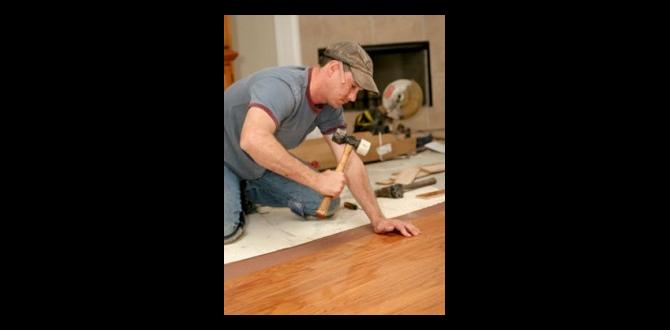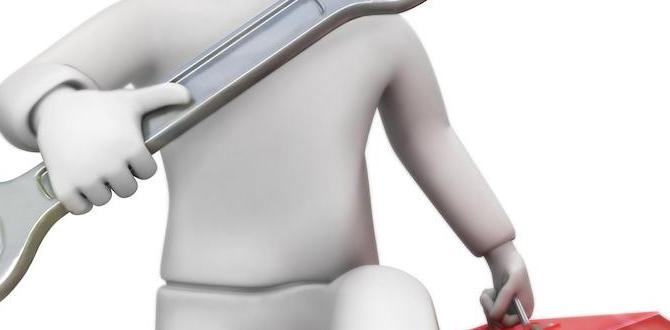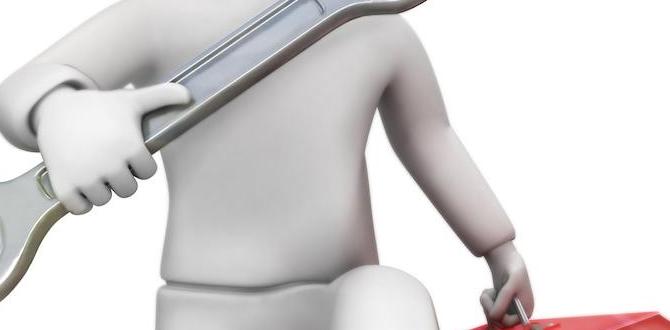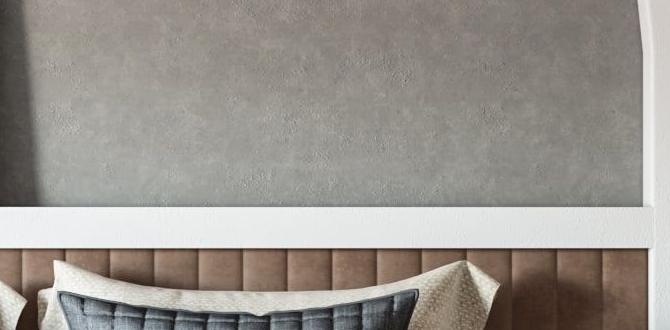Have you ever looked at your hardwood floors and felt sad? Maybe they have scratches or dull spots. You aren’t alone. Many people worry about how to repair hardwood floors. Luckily, it’s easier than it sounds.
Imagine walking into your home and seeing shiny, beautiful floors. Wouldn’t that feel amazing? With the right tips, you can turn your worn-out wood into a masterpiece.
Here’s the good news: you don’t need to be a pro to get perfect results. Some expert tips can help you fix those floors like a champ. From simple cleaning hacks to refreshing techniques, you will learn what it takes to make your floors shine again. Get ready to transform your space!
Table of Contents
How To Repair Hardwood Floors: Expert Tips For Perfect Results When It Comes To Maintaining The Beauty And Functionality Of Your Hardwood Floors, Knowing How To Repair Them Is Essential. Over Time, Hardwood Floors Can Suffer From Various Issues, Such As Scratches, Dents, Or Water Damage. Fortunately, With The Right Expert Tips And Tools, You Can Restore Your Floors To Their Former Glory. Here’S A Comprehensive Guide On How To Repair Hardwood Floors Effectively And Achieve Perfect Results. Understanding Common Hardwood Floor Problems Before Diving Into The Repairs, It’S Important To Understand The Common Problems That Can Occur With Hardwood Floors: – **Scratches And Dents**: These Are Often Caused By Heavy Furniture Or Pet Claws. – **Water Damage**: Spills That Are Not Cleaned Promptly Can Cause Warping Or Discoloration. – **Loose Or Cupped Boards**: These Issues May Arise From Humidity Fluctuations Or Improper Installation. Expert Tips For Repairing Hardwood Floors 1. Assessing The Damage Begin By Thoroughly Inspecting Your Hardwood Floors To Identify The Extent Of The Damage. Take Note Of The Specific Areas That Need Attention And Determine Whether A Simple Touch-Up Or A More Comprehensive Repair Is Necessary. 2. Cleaning The Area Before Making Any Repairs, Clean The Affected Area With A Hardwood Floor Cleaner To Remove Dirt And Debris. This Ensures Better Adhesion Of Products Used In The Repair Process. 3. Repairing Scratches For Minor Scratches, A Wood Stain Marker Or A Colored Wax Stick Can Be Effective. Simply Apply The Product To The Scratched Area, Let It Dry, And Buff Lightly With A Soft Cloth. For Deeper Scratches, Consider Using Wood Filler And Sanding The Area Smooth Before Refinishing. 4. Fixing Dents Dents Can Often Be Repaired Using A Damp Cloth And An Iron. Place The Cloth Over The Dent, Apply Heat With The Iron, And The Steam Will Help The Wood Fibers Rise. Once The Dent Is Leveled, Sand The Area Lightly And Apply A Matching Finish. 5. Dealing With Water Damage If You Encounter Water Damage, The First Step Is To Dry Out The Area Thoroughly. For Minor Stains, Attempt To Remove Them With A Mixture Of Vinegar And Water. If The Boards Are Warped, You May Need To Replace Them Or Sand Them Down To Level The Surface. 6. Replacing Loose Or Cupped Boards For Loose Boards, Simply Re-Secure Them With Nails Or Screws. Cupped Boards Will Often Require Professional Help For Proper Replacement To Ensure The Integrity Of The Floor Is Maintained. Final Touches Once All Repairs Are Completed, Consider Applying A Protective Finish To Your Hardwood Floors. This Will Enhance Their Shine And Provide A Layer Of Protection Against Future Damage. Regular Maintenance, Such As Cleaning And Refinishing, Will Also Help Prolong The Life Of Your Hardwood Floors. Conclusion Repairing Hardwood Floors May Seem Daunting, But With These Expert Tips, You Can Achieve Perfect Results. Regular Inspections And Prompt Repairs Will Keep Your Floors Looking Beautiful For Years To Come. Remember, Whether It’S Handling Scratches, Dents, Or Water Damage, A Little Care Goes A Long Way In Maintaining The Charm Of Your Hardwood Floors.

How to Repair Hardwood Floors: Expert Tips for Perfect Results
Repairing hardwood floors can seem tough. But with expert tips, it becomes easy! Start by identifying the damage, whether scratches or dents. Did you know that a little vinegar can help remove some stains? Gather your tools and follow simple steps for sanding and refinishing. Even minor fixes can make old floors shine again. The right techniques bring back life to your space. Ready to transform your floors? Let’s dive into these repair tips!Understanding Common Hardwood Floor Issues
Types of damage (scratches, dents, warping). Identifying the cause of the damage.Many hardwood floors can face problems over time. Common issues include scratches, dents, and warping. Each type of damage can come from different causes. Scratches might be caused by pets or moving furniture. Dents can happen due to heavy objects falling. Warping usually results from moisture or humidity. Knowing these damages will help in repairing and taking care of your floor.
What are the types of hardwood floor damage?
Common types include scratches, dents, and warping. Each type requires different attention for repair.
Identifying the causes:
- Scratches – Often from pets or furniture.
- Dents – Caused by heavy items dropping.
- Warping – Usually due to moisture or humidity.
Essential Tools and Materials for Repairs
List of tools required (sanders, fillers, etc.). Recommended materials (stains, sealers, finishes).Getting your hardwood floors fixed is like a fun adventure! First, you will need some essential tools. Grab a sander, as it helps smooth out rough spots. Fillers come next for hiding those pesky dents. Don’t forget a measuring tape — it won’t make your floors any better, but it helps you measure twice! Now for materials, you should have stains to make your floors pop and sealers to protect them. Here’s a quick list:
| Tools | Materials |
|---|---|
| Sander | Stains |
| Fillers | Sealants |
| Measuring Tape | Finishes |
With these items, you’ll be on your way to perfect floors. It’s almost as easy as pie — if only pie didn’t require baking! So, roll up your sleeves, gather your tools, and let the fun begin!
Step-by-Step Guide to Repairing Scratches
Light scratches vs. deep scratches. Techniques for buffing and filling scratches.Dealing with scratches on hardwood floors can feel like a mystery, but it’s pretty simple! First, light scratches are easy to fix. You can buff them out with a soft cloth and some elbow grease. For deep scratches, you may need to fill them using wood filler. Don’t worry, it’s like fixing a tiny hole in a wall! Below is a quick guide to remember:
| Scratch Type | Repair Technique |
|---|---|
| Light Scratches | Buff with cloth |
| Deep Scratches | Fill with wood filler |
With these tips, you’ll have your floors looking sharp again in no time! Remember, a happy floor is a happy home!
Repairing Dents and Gouges in Hardwood Floors
Methods for lifting dents (steam method). How to fill and blend gouges with wood filler.Dents and gouges in hardwood floors can be fixed! For dents, try the steam method. Wet a cloth and place it over the dent. Then, use a hot iron on top. The heat and moisture will help raise the wood. For gouges, you’ll need wood filler. Choose a filler that matches your floor color. Apply it with a putty knife and smooth it out. Once it dries, sand the area lightly to blend it in.
How to repair gouges in hardwood floors?
Use wood filler that matches your floor color for a seamless look. Apply, smooth out, and sand once dry!Quick Steps to Repair:
- For dents, use steam to lift the wood.
- For gouges, fill with wood filler.
- Blend with sanding for a clean finish.
Dealing with Warped Hardwood Floors
Identifying the type of warping (crown, cup, and twist). Repair techniques for minor and major warping.Warped hardwood floors can feel like a puzzle. First, figure out what kind of warp you have! There are three main types: crown, where the boards curve up in the middle; cup, which dips at the center; and twist, where corners lift. For some minor warping, simply adding weight might help. If it’s major, consider professional help or replacing planks. Remember, it’s not just a floor problem; it’s a “floor-tion” challenge!
| Type of Warping | Description | Repair Method |
|---|---|---|
| Crown | Curves up in the middle | Add weight or moisture |
| Cup | Edges lift, middle dips | Humidity control, potential sanding |
| Twist | Corners lift, barrels slide | Replace affected boards |
Sealing and Finishing Repairs
Importance of sealing after repairs. Steps for applying finish and ensuring a seamless look.Sealing your hardwood floors after repairs is very important. It protects the wood and keeps it looking great. Sealing prevents moisture and dirt from damaging the surface. This can make your repair last longer and look more natural.
Follow these steps for a smooth finish:
- Choose the right sealant for your floor type.
- Make sure the repair area is clean and dry.
- Apply the sealant using a brush or roller.
- Allow it to dry completely before walking on it.
With these steps, your floors will look as good as new!
Why is sealing important?
Sealing protects floors from dirt, moisture, and damage. It helps repairs blend in and last longer.
Maintenance Tips for Preventing Future Damage
Regular cleaning and upkeep routines. Protective measures (mats, humidity control).Keeping your hardwood floors in tip-top shape is easier than you think! Regularly sweeping or vacuuming keeps dust and dirt away, making your floors shine like a star. Use a damp mop for deeper cleaning but don’t turn your floors into a swimming pool—water is not a wood’s best friend! Adding mats at entrances can catch dirt and prevent scratches. Humidity control is key; use a humidifier or dehumidifier to keep levels balanced. Think of it as keeping your floors on a happy diet!
| Tip | Description |
|---|---|
| Regular Cleaning | Sweep and vacuum weekly to remove dirt. |
| Damp Mopping | Mop lightly to avoid excess water. |
| Protective Mats | Place mats at doorways to trap dirt. |
| Humidity Control | Maintain balanced humidity levels. |
When to Call in a Professional
Signs that indicate professional help is needed. How to choose a qualified hardwood floor contractor.Sometimes, fixing hardwood floors can be tricky. Look for signs that you need a pro. Here are some hints:
- Major scratches or dents that don’t buff out
- Holing or large gaps between the planks
- Water damage or dark spots
Choosing the right contractor is important. Ask for their credentials and examples of past work. Check online reviews for feedback. A good contractor works with a solid plan and gives clear estimates.
When Should You Call a Professional?
You should call for help when the damage is too much to handle alone. It’s best to let experts take over if you see signs of trouble.
Conclusion
In summary, repairing hardwood floors is doable with the right tips. Start by cleaning and assessing damage. Use wood filler for cracks and sand the surface smoothly. Don’t forget to refinish the area for a perfect match. With these expert tips, you can restore your floors beautifully! For more details, check out our other articles on home improvement.FAQs
What Are The Most Common Types Of Damage To Hardwood Floors, And How Can They Be Effectively Repaired?The most common damage to hardwood floors includes scratches, dents, and water stains. You can repair scratches by using a wood touch-up marker or filling them with putty. For dents, sometimes you can steam them out by using a damp cloth and an iron. Water stains are trickier, but you can try rubbing the spot with a mixture of vinegar and olive oil. Always remember to gently clean the area before repairs!
What Tools And Materials Do I Need To Repair Scratches And Dents In My Hardwood Flooring?To fix scratches and dents in your hardwood floor, you’ll need a few tools and materials. Grab a soft cloth, wood filler, and sandpaper. You might also want some wood stain that matches your floor. Lastly, have a finishing coat or clear varnish for extra protection.
How Can I Properly Sand And Refinish Hardwood Floors To Achieve A Professional Look?To sand and refinish hardwood floors, start by cleaning the floor. Then, use a floor sander to carefully sand the surface. Move in the same direction as the wood grain. After sanding, vacuum up the dust. Next, apply a wood finish using a clean brush or roller. Let it dry completely before walking on it. Make sure to follow all instructions on the finish can for the best results!
What Are The Steps To Take For Repairing Water Damage On Hardwood Floors?First, you should dry your hardwood floors quickly with fans or a dehumidifier. Next, check for any loose or damaged boards. If you find any, you can replace them. After that, sand the area to make it smooth. Finally, apply new finish or polish to match the rest of the floor.
How Can I Prevent Future Damage To My Hardwood Floors After Completing Repairs?To prevent damage to your hardwood floors, make sure to clean spills right away. Use a soft broom or a vacuum without a beater bar to remove dirt. Place rugs in high-traffic areas to protect the wood. Also, keep furniture legs padded with soft pads so they don’t scratch. Finally, avoid letting pets run on the floors without supervision.



